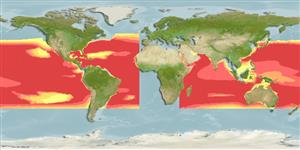Common names from other countries
>
Beryciformes (Sawbellies) >
Cetomimidae (Flabby whalefishes)
Etymology: Cetostoma: Greek, ketos = a marine monster, whale + Greek, stoma = mouth (Ref. 45335).
Environment: milieu / climate zone / depth range / distribution range
Ecologia
marino batipelagico; distribuzione batimetrica 0 - 2250 m (Ref. 6715). Deep-water; 50°N - 40°S, 35°E - 13°W
Atlantic Ocean: between 50°N to 40°S; one specimen was recorded at 30°45'N, 25°47'W (Ref. 6715) and 8 specimens from 28°N, 16°E. Indian Ocean: between15°N and 31°S. Pacific Ocean: between 45°N and 15°S, and off central California, USA.
Size / Peso / Age
Maturity: Lm ? range ? - ? cm
Max length : 24.7 cm SL maschio/sesso non determinato; (Ref. 9791)
Spine dorsali (totale) : 0; Raggi dorsali molli (totale) : 29 - 37; Spine anali: 0; Raggi anali molli: 26 - 34; Vertebre: 47 - 53.
Normal diurnal distribution is between 700 and 1200 m The shallowest diurnal capture (500-600 m) is of one of the smallest specimens (4.3 cm) and the deepest (1500-1600 m) is of one of the largest (20.4 cm), indicating a trend for the diurnal depth to increase with increasing size (Ref. 9791). Nocturnal distribution is between 110-700 m (Ref. 9791). Feeds on decapods and euphausiids (Ref. 6715). Minimum depth from Ref. 58018.
Life cycle and mating behavior
Maturities | Riproduzione | Spawnings | Egg(s) | Fecundities | Larve
Paxton, J.R. and D.J. Blake, 1990. Cetomimidae. p. 607-608. In J.C. Quero, J.C. Hureau, C. Karrer, A. Post and L. Saldanha (eds.) Check-list of the fishes of the eastern tropical Atlantic (CLOFETA). JNICT, Lisbon; SEI, Paris; and UNESCO, Parisl. Vol. 2. (Ref. 6532)
IUCN Red List Status (Ref. 130435)
CITES (Ref. 128078)
Not Evaluated
Threat to humans
Harmless
Human uses
Strumenti
Special reports
Download XML
Fonti Internet
Estimates based on models
Preferred temperature (Ref.
115969): 4.9 - 13.9, mean 8.1 (based on 1132 cells).
Phylogenetic diversity index (Ref.
82804): PD
50 = 1.0000 [Uniqueness, from 0.5 = low to 2.0 = high].
Bayesian length-weight: a=0.00389 (0.00180 - 0.00842), b=3.12 (2.94 - 3.30), in cm Total Length, based on all LWR estimates for this body shape (Ref.
93245).
Trophic level (Ref.
69278): 3.4 ±0.45 se; based on food items.
Resilienza (Ref.
120179): Medio, tempo minimo di raddoppiamento della popolazione 1.4 - 4.4 anni (Assuming tmax>3).
Fishing Vulnerability (Ref.
59153): Low vulnerability (22 of 100).
